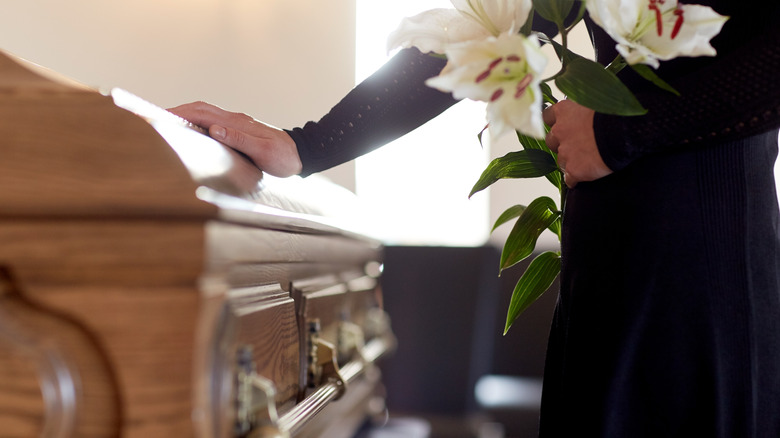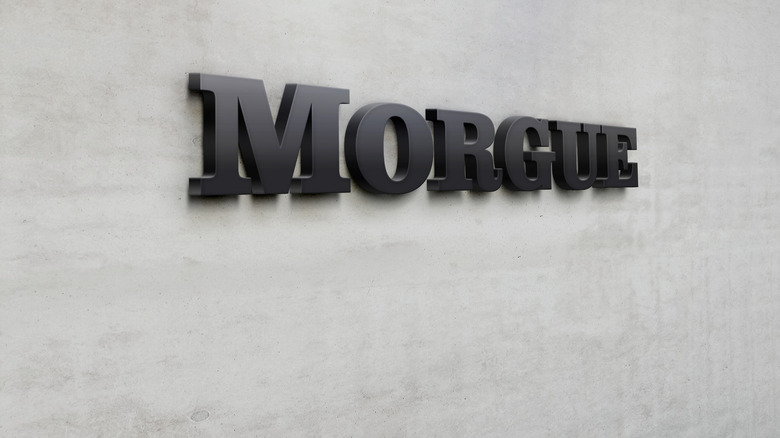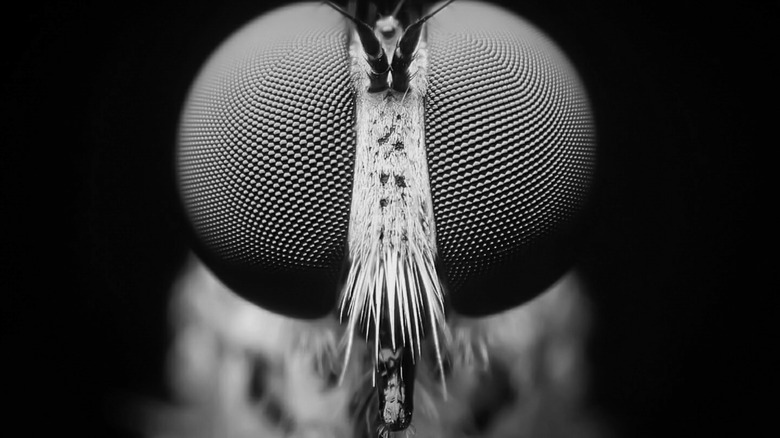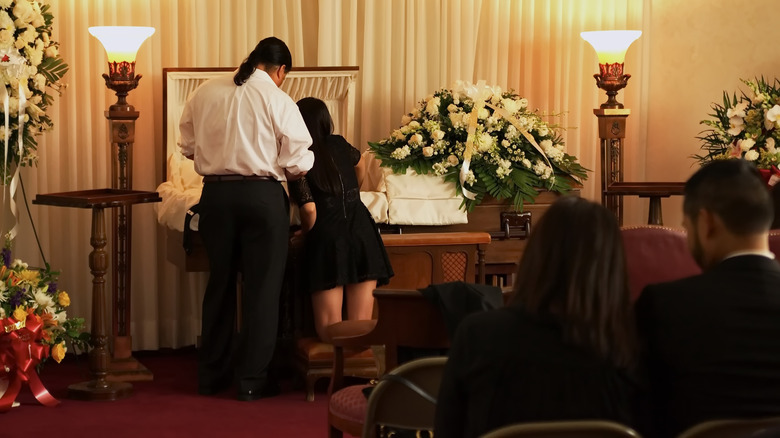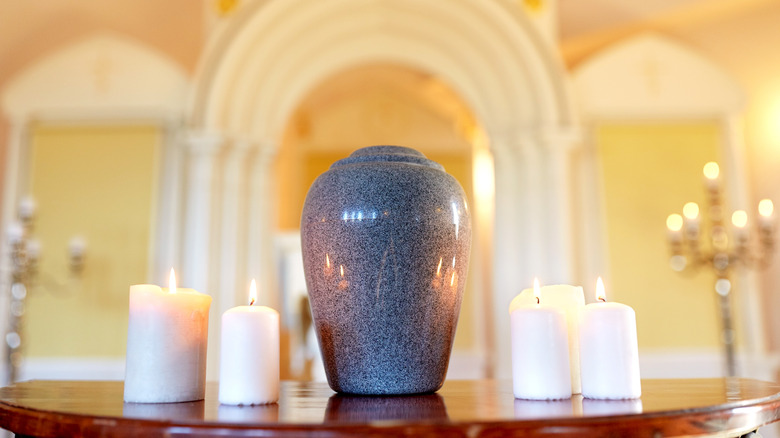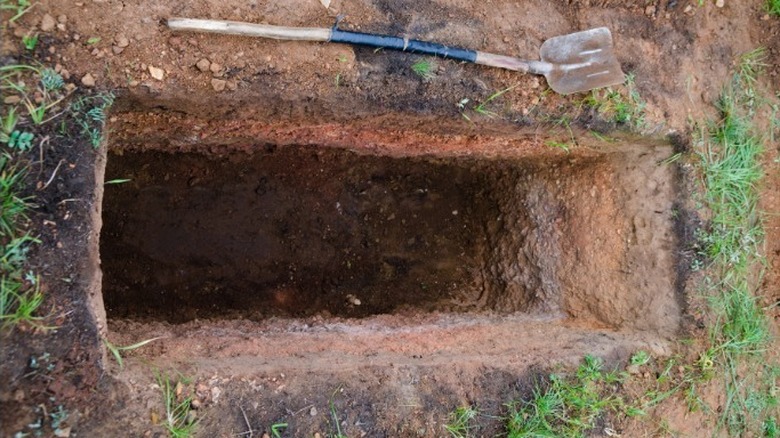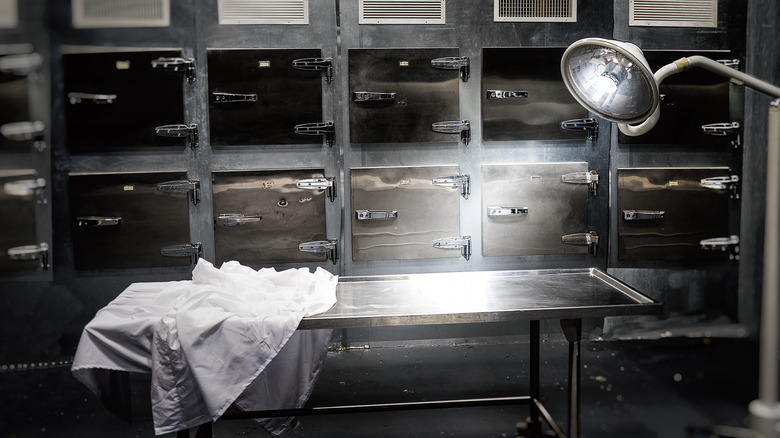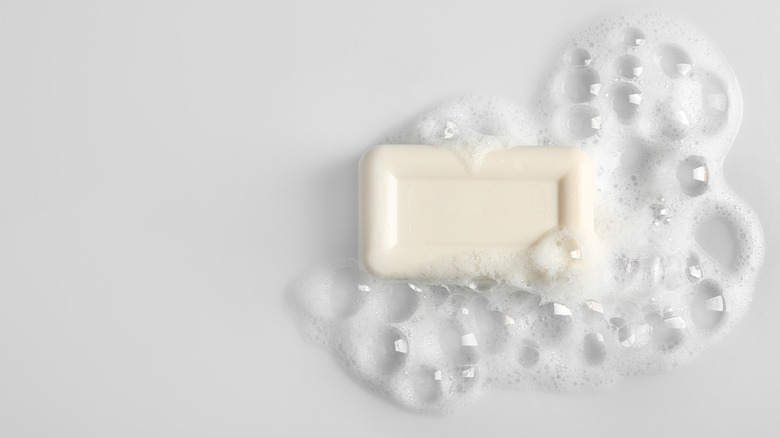What Happens To Your Body When You Die
Thanatology, the study of death, yields all sorts of fascinating information. Like the fact that Anglo-Saxons used to cut the feet off the dead to keep corpses from walking away (via Bustle). Or that the English language has more than 200 euphemisms for death. Or that some non-human primates exhibit behaviors like guarding, visiting, or holding vigils over the body of a dead companion (University of Oxford). But you don't have to be a thanatologist to know the most basic statistic about death: Its prevalence among humans is 100%.
And yet, for something we'll all inevitably experience, most of us know precious little about what happens to us after we die — not in terms of a spiritual or religious afterlife, but right here on earth. True, it may be disturbing to face one's own mortality ... but aren't you a little bit curious? Besides, research shows that thinking about death can contribute to a good life. So let's lift the coffin lid and find out what goes on after the lights go out.
Your body cools down slowly after you die
By definition, when life ceases, metabolism stops, which means your no-longer active cells and tissues stop producing heat. And your body's mechanisms for maintaining body temperature aren't in play anymore either. The result is what's called algor mortis, the cooling of the body until it reaches the temperature of its surroundings, according to a report in StatPearls.
The temperature of a dead body can be a clue to how much time has passed since the moment of death, what's called the "postmortem interval." However, this isn't as straightforward as you might think. A cadaver's temperature might not start to drop for 30 minutes to an hour after death, or even for as long as five hours. After that, the rate of heat loss is affected by many variables, including the position of the body, the presence of clothing, climate, and other factors, explained "Forensic Ecogenomics" (via ScienceDirect).
In one study, estimates of time and death based on body temperature were off by as much as 60% (per StatPearls). In any case, a body will typically reach ambient temperature in 18 to 20 hours, making algor mortis suitable as forensic evidence only within the first 24 hours.
Rigor mortis comes, and then goes
You've probably heard of rigor mortis, the stiffening of the muscles that happens after death. It's one of a classic triad of post-mortem bodily changes that have been observed since ancient times, the other two being algor mortis, or cooling of the body, and livor mortis, or change in skin color (more about that later). But it wasn't until the modern era, when scientists could examine muscle tissue under the microscope, that rigor mortis became understood. This phenomenon occurs because the fibers that make up muscle tissue need an energy source to detach from each other and relax the muscle. With the body's metabolism halted, they're locked in place until they start to decompose.
Rigor mortis occurs in a regular pattern that can help determine the time of death, though it's affected by environmental conditions and other factors. Typically it begins in the small muscles of the eyelids, after 1 to 2 hours postmortem, then progresses to the jaw, trunk, chest, arms, and legs, with the fingers and toes being the last body parts affected, usually within 12 hours. It disappears in the same order that it appeared, with the muscles flaccid again about 36 hours after death, a report in the Journal of Forensic Sciences and Criminal Investigation explained.
Your skin changes color
One of the earliest changes that a body undergoes after death is called "livor mortis," also called "lividity." Because the heart and circulation system are no longer functioning, blood no longer circulates through the body. So gravity causes blood to pool in the parts of the body that are lowest to the ground (via Experimental and Applied Acarology). The process can be seen as early as 15 minutes after death, as outlined in "Human Body Decomposition" (via ScienceDirect). But more usually, the skin in the affected areas becomes visibly red due to pooled blood after an hour or two.
Later, as the blood loses oxygen, the red coloration changes to purple. Initially, skin that displays lividity will blanch, or turn pale, when pressure is applied. But after four to six hours, livor mortis becomes "fixed," meaning that the skin stays discolored if pressed. That's because the blood vessels have become constricted and won't allow the pooled blood to move away from the skin.
The characteristics of livor mortis make it a candidate to help determine the time elapsed since death. But like other postmortem physical changes, lividity can be affected by a number of factors that limit its usefulness, including the ambient temperature and the cause of death (per "Human Body Decomposition").
Your hair and nails seem to keep growing after you die, but they don't
Maybe you've heard the myth that after you die, your hair and fingernails keep growing. Among other places, the idea is mentioned in the novel "All Quiet On The Western Front." Johnny Carson even made a joke about it: "For three days after death, hair and fingernails continue to grow, but phone calls taper off" (via British Medical Journal). But yes, we did just call it a myth, because that's what it is.
Hair and nails grow in a similar manner: As living cells at the base grow and multiply, they push the dead tissue of the hair or nail outward, making it longer. And like all the cells of your body, those living cells need nutrients to survive. When you die, no more nutrients are delivered, so growth stops. However, this myth of postmortem growth may have its root in another after-death phenomenon, reported the BBC. Sometimes dehydration causes the skin of a cadaver to retract or pull back, which could make hair or fingernails seem as if they've become longer. Tightening of the skin on the face can even make beard stubble seem like it's grown.
Your body starts to dissolve itself after you die
Mother nature is nothing if not efficient. Not only do bodies break down to their components in a kind of natural recycling effort after death, but they already contain everything needed to get the process started. Mere minutes after death, our oxygen-deprived cells start becoming acidic, and as a result the enzymes that they use for digestion leak out, according to Scientific American. As the body's own chemicals start breaking down and dissolving cells, tissues, and organs — a process called autolysis (aka self-digestion) — the trillions of bacteria that live in and on our body start getting busy.
No longer kept in check by the immune system, they spread and multiply, feeding and accelerating the decomposition process. The digestive system is a particularly rich source of these opportunistic germs, which spread from the intestines to the liver and then to the heart and brain. One study found that gut bacteria could spread to all areas of the deceased within 58 hours (via The Guardian). It would be enough to make you appreciate how hard your body worked to keep microbes under control — but of course, you wouldn't be there to appreciate it.
Your eyes might stay open
Hamlet famously asked, "In that sleep of death, what dreams may come?" In Greek mythology, sleep and death are bros. We tend to think of both as related, at least metaphorically, so it's no surprise that we equate closed eyes with a more peaceful, sleep-like "resting in peace" for the deceased. In fact, Hippocrates himself considered it a bad sign if someone close to death didn't completely close their eyes.
However, closed eyes at death aren't a given. One study in the Indian Journal of Palliative Care examined the records of 100 hospice deaths and found that 63% of patients died with their eyes closed, while 37% had both eyes at least partly opened. According to the researchers, total eye closure is usual in death, while dying with eyes open is probably the result of damage to the nervous system that affects the eyelids. In their study, the deceased's behavior wasn't related to their eye closure at death, contradicting the common belief that dying with open eyes is the result of fear, guilt, or discomfort.
Nevertheless, open eyes are upsetting for family and loved ones; keeping the deceased's eyes shut is likely the reason for the ancient custom of putting coins on the eyes. In modern times, morticians use special plastic caps which fit under the eyelids and keep them shut for the viewing and funeral.
Bugs and bacteria will keep you company
In one sense, we all die alone. In another, more disgusting sense, a dead body that's left alone will inevitably have plenty of company. The smell of a decaying body — thanks to chemicals like the aptly-named cadaverine and putrescene — attracts insects that consume dead tissue, according to Mosaic. Certain flies, like the blowfly and flesh fly, lay eggs in a cadaver's wounds or openings, as many as 250 eggs per fly. The maggots that hatch from those eggs feast and grow, and if left to their own devices there may be enough of them to raise the body's temperature by 10 degrees Celcius. The community of maggots even moves around inside the body en masse, to keep from getting too warm (via Gizmodo).
But wait, there's more. The presence of maggots attracts predators like beetles, ants, wasps, and spiders to feed on them. Bacteria from the local environment move in as well. The colonization of a corpse by outside organisms is aided by the process of purification, which occurs when particular bacteria that feed on bodily tissues release gaseous byproducts like methane and ammonia. These gases inflate or bloat the abdomen, sometimes causing it to burst, and they cause blisters and detachment of the skin. All of which exposes more of the body to outside invasion, per Gizmodo.
If you're embalmed, this is what happens
Though cremation is much more common these days, a conventional burial is still a choice for many families, who consider embalming to be part of standard funeral arrangements (via National Funeral Directors Association). But what is embalming?
The embalming process doesn't prevent a body from decomposing, but it does delay the process, with the goal of allowing mourners to see their loved one in a familiar, peaceful state as part of the grieving process. The funeral trade calls this "creating a beautiful memory picture." Since nature really, really, really wants dead bodies to decompose, embalming is a complicated procedure with many steps. This includes massaging the body, applying creams, "setting" facial features using glue and other products, injecting formaldehyde, draining fluids, and applying makeup, among other things (via the Funeral Consumers Alliance).
Embalming dates back to the time of the Civil War when some families paid to have deceased soldiers embalmed and brought home for burial. But it was the embalming of President Lincoln that led the general public to embrace the practice (via Smithsonian Magazine).
If you're cremated, this is what happens
Odds are there's cremation in your future. According to the National Funeral Directors Association, cremation rates surpassed casketed burials in 2015, and will likely continue to rise. By 2040, they say, burials will account for only 16% of funeral services. Disposing of the dead by fire is an ancient funerary practice, known in the Western world since the Greeks of 1,000 BCE, and probably practiced as early as the stone age, according to the Cremation Association of North America. But modern cremation is a more complicated process than you might think.
The body, in a flammable container, is placed into a brick-lined cremating chamber, where it's ignited by a column of flame at a temperature of up to 2,000 degrees Fahrenheit. A secondary chamber is also ignited, to burn up any particles or dust that's emitted, and reduce emissions and smoke. The average body is completely combusted in two to three hours.
That's not the end of it, though. At this point, the 3 to 9 pounds of physical remains include recognizable bones. So the incinerator, which is usually automated and computer controlled, sweeps the bones into a grinder that pulverizes the brittle skeletal fragments into the ashes that end up in an urn or other container. First, a powerful magnet removes any metal remnants, like fillings or plates (via HowStuffWorks.com).
If you have a green burial, there's no embalming, coffin, or vault
For those concerned about the expense and ecological footprint of embalmed, casketed burial or cremation, so-called "green burial" is an increasingly popular option. As the name suggests, the idea is to intern a body in the ground in a manner that's ecologically friendly. According to the Green Burial Council, a nonprofit organization that certifies cemeteries and funeral homes, there are more than 300 green burial cemeteries in the United States and Canada. A 2017 poll by the National Funeral Directors Association found that about 50% of Americans are interested in green funeral options.
A green burial means forgoing the embalming process. The deceased is laid to rest in a casket of biodegradable materials, or simply wrapped in a fabric shroud. The grave does not include a burial vault or liner, that is, the outer container that surrounds a casket under the ground. (In case you're wondering, a burial of at least 3.5 feet below the surface ensures no animals will smell the decomposition.) The idea is to minimize environmental impact and reduce carbon emissions, but also to protect funeral workers from toxic chemicals and restore or preserve the burial habitat.
A green burial might include a home funeral service (via Home Funeral Alliance). Contrary to what you may think, it's legal to care for a deceased loved one at home, though some states have restrictions. Alternatively, the body can be prepared by a conventional funeral home that offers green burial services.
Your organs may not be donated despite you being an organ donor
Should you choose to donate your organs after death, you could save up to eight lives, and improve as many as 75 more (via OrganDonor.gov). As of this writing, there are nearly 107,000 people on the national organ donor waiting list, and on average 17 people die every day waiting for a transplant. All of these facts are, of course, compelling reasons to donate. But not everyone who chooses to be an organ donor actually results in a donation.
For one thing, only three out of 1,000 people die in a way that allows for an organ donation, per OrganDonor.gov. Also, simply carrying an organ donor card, or having it marked on your driver's license, isn't enough to ensure donation — these things might get overlooked. What you need to do is sign up via your state's registry. Then, should conditions allow, upon your demise a hospital will contact the local Organ Procurement Organization to evaluate your suitability as a donor (only after a doctor confirms brain death).
Your registry with your state is considered legal consent for donation, but it's good idea to let your next of kin know in advance so they understand your wishes. There's no cost to the deceased's family for the donation process, and the removal procedure typically doesn't prevent an open-casket funeral (via National Kidney Foundation).
If no one claims your body, it might be given to a med school
What happens to someone if they die, and there's no next of kin to claim the body or prior arrangement? The answer depends on where the deceased kicked the bucket. In most U.S. states, the final disposition of an unclaimed body is the responsibility of a local municipality, like a county, town, or city, which must use its budget to pay a funeral provider for the service. In the other cases, it's the state budget that covers the cost (via The Oregonian).
The amount that's spent on such funeral services varies by location, ranging from about $200 to as much as $2,500. The mandated services vary as well, and may or may not include a casket, grave marker, or burial cloth. But in all 50 states, unclaimed dead must first be offered to a medical school, or a service that distributes bodies to med schools, dentistry schools, mortuary science schools, and other facilities that have a use for cadavers, per The Oregonian.
Your dead body might move on its own
A body that's left undisturbed doesn't necessarily, uh, rest in peace. As creepy as it sounds, researchers who photographed the decomposition of a donated cadaver over the course of 17 months found that the body changed position on its own (via Medical News Daily). The arms, for example, which were initially alongside the body, were later found to be flung out to one side.
The research was conducted in Australia at a "body farm," i.e., a facility where human bodies can be exposed to the elements for the study of decomposition in a secure, restricted environment (via University of Technology Sydney). Scavenging animals that might have disturbed the remains were excluded from the area. The likely explanation, the researchers said, is that the decomposition process itself caused the body to shift, perhaps due to ligaments drying out.
The phenomenon may have implication for forensic science. When a body is found at a potential crime scene, the position of the cadaver is assumed to be that of the victim at the time of death, unless there's indication otherwise. But this research suggests that even if a body appears undisturbed by outside forces, it may have changed position since postmortem (per Medical News Daily).
Part of your body may turn to soap after you die
"Corpse wax" may sound like a mortuary product used to fit a cadaver into a too-tight coffin. But in fact it's a waxy substance that, under certain conditions, is produced by the corpse itself (via Atlas Obscura). Also known as grave wax or adipocere, the material is the result of a process called saponification, which can occur to body fat that's exposed to certain bacteria in a damp environment, including soil or water. The soapy substance starts off soft and greasy but hardens over time. Extensive saponification can even coat a cadaver and halt the decomposition process, producing so-called "soap mummies." You can see one for yourself at the Mütter Museum in Philadelphia, whose Soap Lady was exhumed in 1875.
More recently, authorities in Switzerland were baffled when a headless soap mummy was discovered floating in a bay in 1996. The mystery was solved when researchers determined it was the body of a man who drowned in the 18th century; sediment at the bottom of the water had triggered saponification (per Atlas Obscura).

